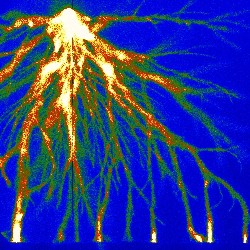Sparks Branch Like Coral Reefs

Sparks branch for the same reason that coral reefs and snowflakes do, according to new computer simulations. Researchers in the Netherlands have found that even the simplest computer model of a propagating streamer–the precursor of a visible spark–predicts that the moving front spontaneously splits and forms branches. The result, appearing in the 29 April print issue of PRL, could help explain the electrical sprites recently observed flickering above the clouds during thunderstorms, and may lead to improved industrial techniques for chemical processing of gases and water purification.
Despite their complicated structure, the basic model for streamers is simple. A single free electron traveling in a strong, uniform electric field ionizes the gaseous molecules around it, generating more electrons and a chain reaction of ionization. The ionized gas creates its own electric field, which speeds up the reaction, and a streamer is born. Eventually its charge and field concentrate in a thin, dome-shaped layer at the tip of the growing streamer. In simulations of this process, most researchers expected streamers to form a tube-shaped channel with a fixed diameter.
They just didn’t turn the initial field up high enough, says Ute Ebert of the Center for Mathematics and Computer Science in Amsterdam. When she and her colleagues simulated streamers propagating in nitrogen at 50,000 volts–twice the field strength of earlier studies–they saw the ionized gas begin to split apart. As the millimeter-scale streamers grew, their curved fronts unexpectedly broadened and thinned, bringing them close to a theoretical limit proposed in the 1970s. In this state, any tiny protrusions in the charge front focus the electric field around them. Because the speed of ionization depends on the surrounding field, these bumps grow faster than the rest of the front, and branching results. A similar mechanism can operate in a coral reef: when one part pulls ahead of the rest, it gets more food and so grows even faster.
Even though streamers are usually a few meters or less in length, this branching mechanism may be at work in the tens-of-kilometers-long electrical sprites reported recently [1]. At low pressures, such massive, high-altitude discharges seem to fork in the same way as sparks found near the ground. Streamers are at work in lightning, too, but because of extra processes involved, Ebert isn’t sure whether the model applies. A better understanding of streamer branching could also improve the efficiency of certain industrial chemical reactions in gases and water purification schemes triggered by electrical discharges.
“Everyone [in the field] will benefit from this publication,” says Victor Pasko of Pennsylvania State University in University Park. The result circumvents existing debates about what factors control the radius of streamers in simple models because it shows that the radius changes, he says. But the authors use new simulation techniques, so he and others will want to check the results for themselves. Indeed, Frazer Williams, of the University of Nebraska in Lincoln, isn’t convinced that the branching they observe is physical in origin; it may be caused by the simulation method itself. Pasko says the work will at the very least generate a lot of responses. “It definitely will spark discussion.”
–JR Minkel
JR Minkel is a freelance science writer in New York City.
References
- V. P. Pasko et al., Nature (London) 416, 152 (2002)
More Information
Response to this paper: Phys. Rev. Lett. 89, 229401 (12 Nov 2002).


